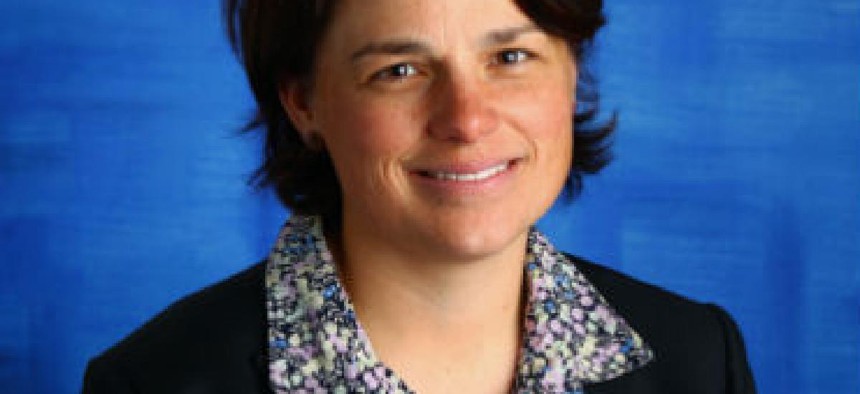Linking research to real life (and to real-world budgets)

With a doctorate in neuroscience and a talent for finding funding, Ivy Estabrooke personifies the Office of Naval Research's straddling of science and military operations.

Office of Naval Research Program Officer Ivy Estabrooke has drawn praise from across the military and intelligence communities for her ability to turn cutting-edge research into operational benefits.
The Office of Naval Research is where science meets operations for the Navy and Marine Corps. A typhoon that ripped through the Philippines last November brought that intersection to the fore.
ONR had spent about three years developing mobile-phone software that collects and stores operational data into a wiki for future use. When Typhoon Haiyan hit, killing more than 6,000 people, Marines who had tested the application -- the Marine Corps Civil Information Management System (MARCIMS) -- were sent to the Philippines to collect data and facilitate disaster relief.
"It gave the commander a much better picture of what was going on and it gave this historical record that was useful to go back … and understand what we had done where, and where we should try to engage going forward," said ONR Program Officer Ivy Estabrooke, who won a 2014 Federal 100 award for her work on MARCIMS and other projects.
MARCIMS is an example of a "science and technology idea that takes hold… [and] is exercised in a way that supports both the needs of the Marine Corps," she added, "but also the partners that we're trying to develop capacity with in other countries, and then having something ready to use when disaster strikes."
Marines like the application because it saves them the tedious work of transcribing their notes from the field. MARCIMS has geospatial layers for different data views and some of its findings can be shared with non-government organizations responding to a crisis.
With a doctorate in neuroscience from Georgetown University, Estabrooke is the personification of ONR's straddling of science and military operations; she is applying a career of scientific research to the far-flung work of the Marine Corps and Navy. A senior Navy Department official praised her ability to live in both worlds: "She has moved the research to where it needs to be."
From Estabrooke's perspective, the key has been engaging stakeholders from the beginning. "One of the interesting things that we learned in [MARCIMS] was the benefit of getting the operational community involved at a very early stage in the development," she said.
She has also found that "there are trade-offs between sexy, exciting, cutting-edge science and something that's usable and will hold up" in the field. "Being comfortable with walking that line is an important thing in tech development."
But when Estabrooke is looking for sexier tech ideas, she might head west to Silicon Valley or north to the suburbs of Boston. ONR has held workshops with tech firms "to try and get small companies to talk to the government, which isn't always something they want to do, frankly, because often their business model is to be bought out, not to take government funding and then have to work with us," she said.
One of ONR's small-business partners is Milcord, a Waltham, Mass.-based IT security firm that designed the semantic wiki in which MARCIMS data is stored. The Army Geospatial Center helped with coding and geospatial layering to round out a partnership that Estabrooke described as the kind "we often strive for but aren't able to do, of small business, government lab and operational community."
'Relevant to the larger community'
Estabrooke's office has managed largely to avoid the stark budget cuts seen in other Defense Department programs. ONR's budget has held steady at $2.3 billion the last two fiscal years and its fiscal 2015 request is $2.2 billion, according to officials. The officials who nominated Estabrooke for the Fed 100 credited her with keeping the money coming, noting that her "expertise and perseverance" persuaded the Navy and DOD to increase their investment in just the Human Social Cultural Behavioral Sciences programs from $250,000 in fiscal 2008 to "more than $40 million" in fiscal 2013.
Dealing with the comptroller's hatchet is less a science than an art of leveraging relationships with other agencies and wringing money out of the right places, Estabrooke's experience indicates.
"As budgets get tighter, there has to be more collaboration across agencies and even across programs within an agency," she said.
Downstairs from her office in Arlington, Va., is the Air Force Office of Scientific Research, which funded a study of how beliefs affect decision-making in which Estabrooke applied her expertise as a neuroscientist.
That kind of close inter-agency relationship kept ONR's Integrated Crisis and Early Warning System alive last year. The program, which offers six-month forecasts of political stability by country and is popular with the departments of State and Defense, was short of money until another agency that Estabrooke declined to name chipped in end-of-year funding.
Keeping other agencies apprised of ONR programs they might find useful and "making sure what you're doing is going to be relevant to the larger community" are among Estabrooke's tips for keeping the fiscal spigot flowing.
Her broader goal in drawing up research programs is to ensure that "anything we develop is going to continue to be available to the government, owned by the government as much as possible and have as small a sustainment tail as humanly possible," she said. To that end, the government owns most of the code for MARCIMS and the political forecasting program.
* * *
GovTV: Estabrooke on the appeal of science
In this 2011 ONR video, Estabrooke discusses what drew her to science, and the appeal and impact of her work in a job that "isn't necessarily where I expected to end up."
NEXT STORY: It's not just about the money





